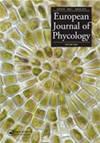New genera of thin homocyted cyanobacteria from Brazilian tropical and subtropical marine islands
IF 1.7
4区 生物学
Q2 MARINE & FRESHWATER BIOLOGY
引用次数: 0
Abstract
ABSTRACT Brazil’s Atlantic Ocean coast is approximately 7500 km long, with several coastal and oceanic islands. The cyanoflora of this area is not commonly included in published studies, resulting in an underestimated diversity. Here, we isolated and analysed through a polyphasic approach three strains of marine benthic homocyted cyanobacteria from Brazilian coastal islands with two distinct climates: ALCB 132761 and ALCB 132774 are from the tropics, and ALCB 132760 from the subtropics. These strains presented differences in their cell morphometry and presence/absence of sheath, but were similar in apical cell shape, colour, and form of the trichome. In the 16S rRNA phylogeny, Maximum likelihood (ML) and Bayesian posterior probability (PP) analyses placed our strains in two robust clades. We propose that Microlinema tropicalium gen. et sp. nov. (ALCB 132774) is placed in the Leptolyngbyaceae, and Insularia amadoi gen. et sp. nov. (ALCB 132761) and Salileptolyngbya insularis sp. nov. (ALCB 132760) in Pseudanabaenaceae. The 16S-23S Internal Transcribed Spacer (ITS) was used to reconstruct Box B and D1-D1’ secondary structures, which were treated as autapomorphic characters. The new thin homocyted benthic cyanobacterial taxa described here from marine coastal islands of Brazil help to disentangle the Leptolyngbyaceae and Pseudanabaenaceae. HIGHLIGHTS •Polyphasic description of two new Brazilian genera Insularia and Microlinema. •Expansion of Salileptolyngbya: recognition of one species for the Atlantic Ocean. •Elucidation of benthic genera in the Leptolyngbyaceae and Pseudanabaenaceae.巴西热带和亚热带海岛薄同型蓝藻新属
本文章由计算机程序翻译,如有差异,请以英文原文为准。
求助全文
约1分钟内获得全文
求助全文
来源期刊

European Journal of Phycology
生物-海洋与淡水生物学
CiteScore
4.80
自引率
4.20%
发文量
37
审稿时长
>12 weeks
期刊介绍:
The European Journal of Phycology is an important focus for the activities of algal researchers all over the world. The Editors-in-Chief are assisted by an international team of Associate Editors who are experts in the following fields: macroalgal ecology, microalgal ecology, physiology and biochemistry, cell biology, molecular biology, macroalgal and microalgal systematics, applied phycology and biotechnology. The European Journal of Phycology publishes papers on all aspects of algae, including cyanobacteria. Articles may be in the form of primary research papers and reviews of topical subjects.
The journal publishes high quality research and is well cited, with a consistently good Impact Factor.
 求助内容:
求助内容: 应助结果提醒方式:
应助结果提醒方式:


